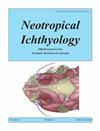Environmental predictors of the life history of the flag tetra Hyphessobrycon heterorhabdus (Characiformes: Characidae) in streams of the Eastern Amazon
IF 2
4区 生物学
Q1 ZOOLOGY
引用次数: 0
Abstract
Abstract This study aimed to characterize the reproductive biology of Hyphessobrycon heterorhabdus, and its response to environmental variations in the Eastern Amazon streams. We sampled specimens every two months, between March 2019 and January 2020. The population was evaluated for sex ratio, reproductive activity, growth pattern, condition factor, size at the first sexual maturation, spawning type, and fecundity. We analyzed 180 specimens, which showed a sex ratio of 1.6 males for each female across the whole period, with 2.3 males for each female during the period of greatest reproductive activity. The peak of reproductive activity coincided with higher precipitation periods and was partially predicted by factors such as water temperature, stream discharge, dissolved oxygen, substrate complexity, and electrical conductivity. The length where 50% and 100% of population to reach sexual maturity was 18.0 and 22.0 mm for males and 19.7 and 27.0 mm for females. The oocyte diameters showed a bimodal frequency, with at least two batches of oocytes. The average fecundity of 197 oocytes. The results indicate that this species presents an opportunistic strategy, and the tactics that make up this strategy depend on variations in both the physical structure of the habitat and physicochemical aspects of the water.东亚马逊河河流中旗鱼四种(特征:旗鱼科)生活史的环境预测因子
摘要本研究旨在研究亚马逊河东部河流中异habdus的生殖生物学特征及其对环境变化的响应。我们在2019年3月至2020年1月期间每两个月采样一次。对种群的性别比、繁殖活动、生长模式、条件因子、初次性成熟时的大小、产卵类型和繁殖力进行了评价。我们分析了180个样本,发现整个时期的性别比为1.6:1,在繁殖最活跃的时期,性别比为2.3:1。水温、水流流量、溶解氧、基质复杂性和电导率等因素可部分预测繁殖活动的高峰。50%和100%种群达到性成熟的体长雄性分别为18.0和22.0 mm,雌性分别为19.7和27.0 mm。卵母细胞直径呈双峰频率,至少有两批卵母细胞。197个卵母细胞的平均繁殖力。结果表明,该物种表现出一种机会主义策略,而构成这种策略的策略取决于栖息地的物理结构和水的物理化学方面的变化。
本文章由计算机程序翻译,如有差异,请以英文原文为准。
求助全文
约1分钟内获得全文
求助全文
来源期刊

Neotropical Ichthyology
生物-动物学
CiteScore
2.80
自引率
17.60%
发文量
24
审稿时长
6-12 weeks
期刊介绍:
Neotropical Ichthyology is the official journal of the Sociedade Brasileira de Ictiologia (SBI). It is an international peer-reviewed Open Access periodical that publishes original articles and reviews exclusively on Neotropical freshwater and marine fishes and constitutes an International Forum to disclose and discuss results of original research on the diversity of marine, estuarine and freshwater Neotropical fishes.
-Frequency: Four issues per year published only online since 2020, using the ‘rolling pass’ system, which posts articles online immediately as soon as they are ready for publication. A searchable and citable Digital Object Identifier (DOI) is assigned to each article immediately after online publication, with no need to await the issue’s closing.
-Areas of interest: Biology, Biochemistry and Physiology, Ecology, Ethology, Genetics and Molecular Biology, Systematics.
-Peer review process: The Editor-in-Chief screens each manuscript submitted to Neotropical Ichthyology to verify whether it is within the journal’s scope and policy, presents original research and follows the journal’s guidelines. After passing through the initial screening, articles are assigned to a Section Editor, who then assigns an Associate Editor to start the single blind review process.
 求助内容:
求助内容: 应助结果提醒方式:
应助结果提醒方式:


